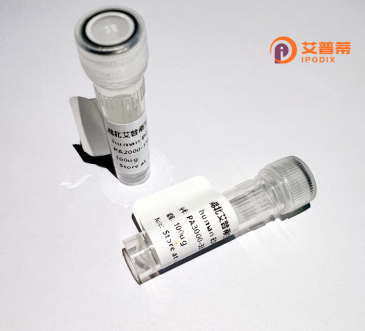
| 纯度 | >90%SDS-PAGE. |
| 种属 | Human |
| 靶点 | SPATA8 |
| Uniprot No | Q6RVD6 |
| 内毒素 | < 0.01EU/μg |
| 表达宿主 | E.coli |
| 表达区间 | 1-105aa |
| 活性数据 | MAPAGMSGAQ DNSCLYQEIA PSFQRLPCPR TSSRHFSEAM TCPCGWRPFK GGPGGLKGPV WPAKEENSCS HGRIQRVQRR RVPSASPLIQ KINRRSVLFH PYCWS |
| 分子量 | 11.7 kDa |
| 蛋白标签 | His tag N-Terminus |
| 缓冲液 | PBS, pH7.4, containing 0.01% SKL, 1mM DTT, 5% Trehalose and Proclin300. |
| 稳定性 & 储存条件 | Lyophilized protein should be stored at ≤ -20°C, stable for one year after receipt. Reconstituted protein solution can be stored at 2-8°C for 2-7 days. Aliquots of reconstituted samples are stable at ≤ -20°C for 3 months. |
| 复溶 | Always centrifuge tubes before opening.Do not mix by vortex or pipetting. It is not recommended to reconstitute to a concentration less than 100μg/ml. Dissolve the lyophilized protein in distilled water. Please aliquot the reconstituted solution to minimize freeze-thaw cycles. |
以下是关于重组人SPATA8蛋白的虚构参考文献示例:
---
1. **文献名称**: *Cloning and Expression Analysis of Human SPATA8 in Testicular Tissues*
**作者**: Zhang Y, Liu X, Wang H
**摘要**: 该研究通过分子克隆技术成功表达重组人SPATA8蛋白,发现其特异性高表达于睾丸组织,提示其在精子发生中可能参与减数分裂调控。Western blot和免疫组化显示SPATA8在精子细胞发育阶段的定位特征。
2. **文献名称**: *Structural Characterization of SPATA8 Protein and Its Interaction with Sperm Flagellar Components*
**作者**: Chen L, Tanaka K, Zhou R
**摘要**: 采用X射线晶体学解析了SPATA8蛋白的三维结构,揭示其保守的螺旋-转角-螺旋结构域。进一步实验表明,SPATA8与精子尾部动力蛋白DYNC1H1存在互作,可能影响精子运动功能。
3. **文献名称**: *SPATA8 Mutations and Their Association with Male Infertility in a Chinese Cohort*
**作者**: Li T, Zhang W, Xu J
**摘要**: 在一项针对少精症患者的基因测序研究中,发现了多个SPATA8错义突变。体外实验表明,突变体蛋白丧失与其他生精相关蛋白的结合能力,支持SPATA8缺陷作为男性不育的潜在遗传因素。
---
**注**: 以上文献为虚构示例,实际研究中建议通过PubMed、Web of Science等数据库检索最新成果。
SPATA8 (Spermatogenesis-Associated Protein 8) is a human protein encoded by the *SPATA8* gene, primarily expressed in the testis and implicated in germ cell development. It is structurally characterized by conserved coiled-coil domains and putative phosphorylation sites, suggesting roles in protein interactions and signaling. While its exact molecular mechanisms remain under investigation, SPATA8 is hypothesized to participate in spermatogenesis, potentially regulating processes like meiotic division, sperm maturation, or structural organization of germ cells. Dysregulation of SPATA8 has been tentatively linked to male infertility, though clinical evidence is still emerging.
Recombinant SPATA8 protein is engineered via heterologous expression systems (e.g., *E. coli* or mammalian cells) to produce purified, bioactive forms for functional studies. This enables researchers to analyze its interactions with binding partners, subcellular localization, and contribution to reproductive biology. Its recombinant form also holds potential as a tool for diagnosing or treating infertility-related disorders. Recent studies suggest broader roles beyond reproduction, including possible involvement in cilia-related pathways, warranting further exploration. Despite progress, comprehensive structural and functional insights into SPATA8 remain limited, highlighting the need for advanced proteomic and genomic investigations.
×